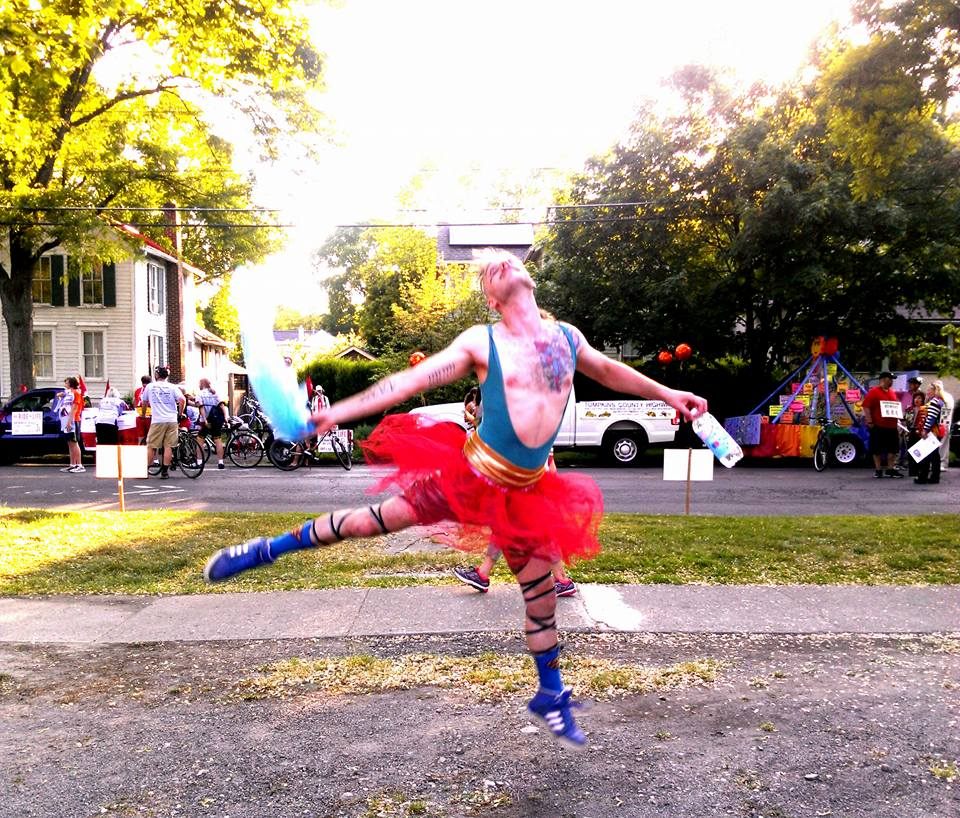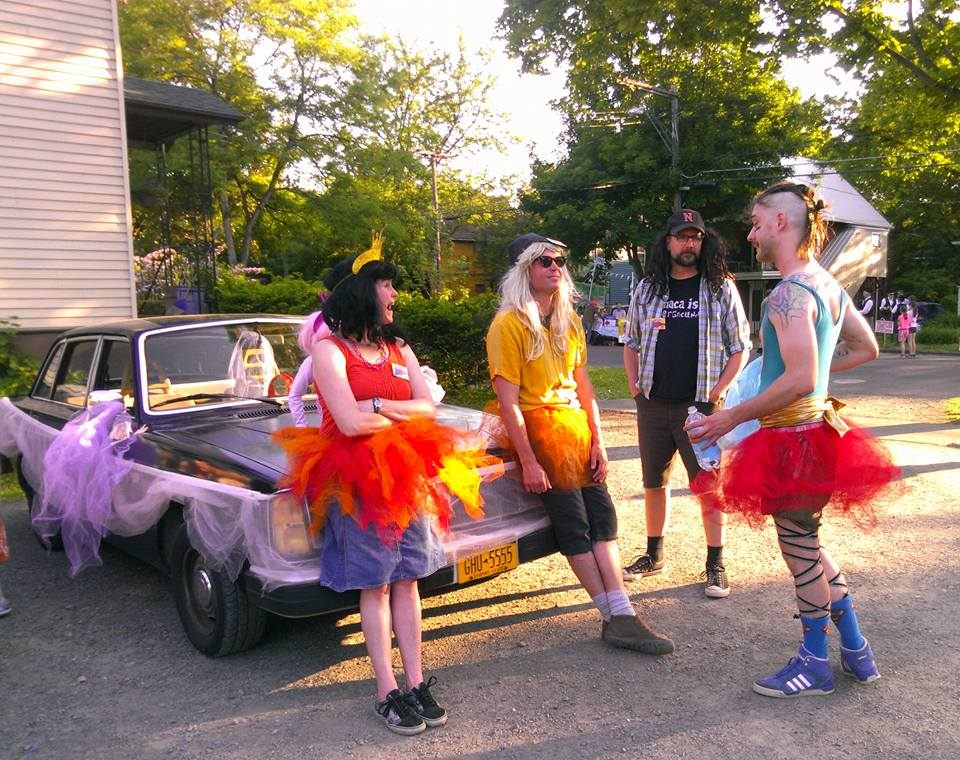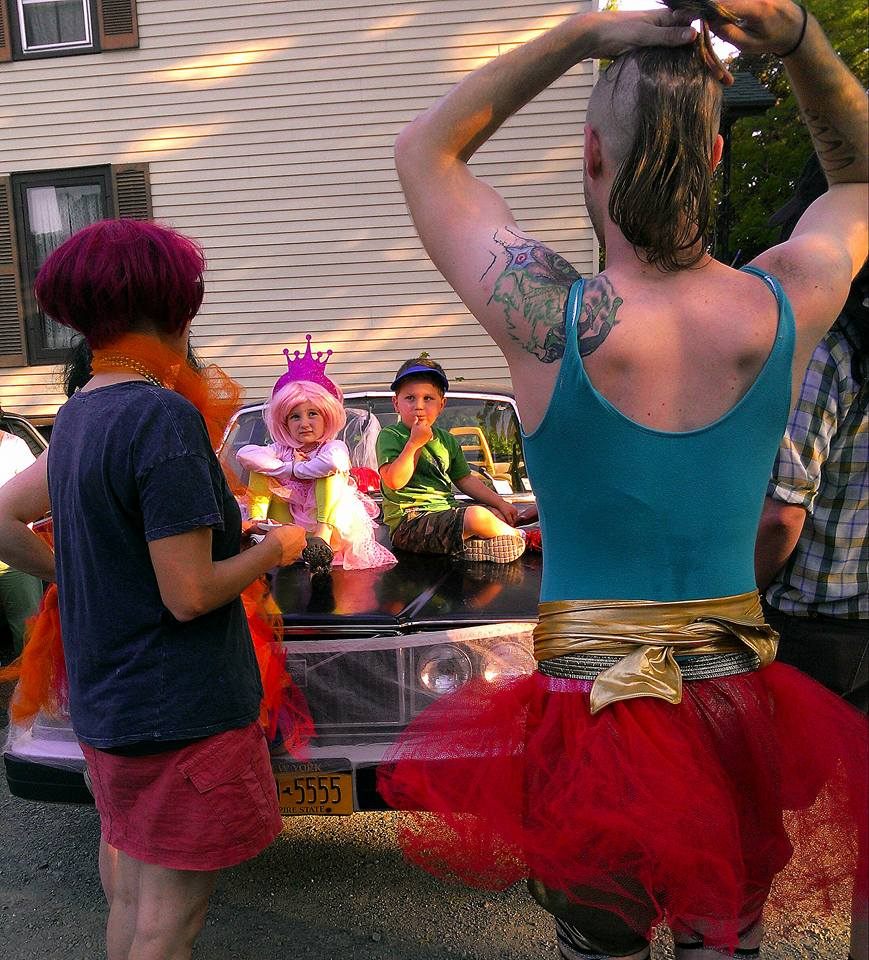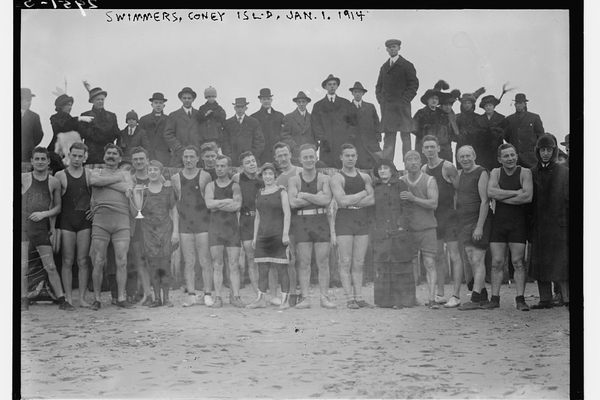Why Are These Cars Wearing Tutus? Ask The Male Ballerinas

The Volvo Ballet, 2015 (Photo: Courtesy of Kendra Lin)
It’s summer in America, and in towns small and large, parades of firetrucks, baton-tossing marching bands, and distinguished old automobiles move haltingly down Main Streets. In Ithaca, New York, the town parade happens on the first day of the yearly Ithaca Festival, and, like so much else in the city, a college town sometimes referred to as “ten square miles surrounded by reality,” the parade has its own unique spin on tradition.
The Ithaca Festival parade includes hula dancers and stilt-walkers, a He Man Chainsaw Marching Band, and bongo drummers. But of all the weirdly wonderful sections of the parade, however, the creatively gender-bending Volvo Ballet is the most famous.
In the ballet, the Volvos—there are usually five or six—wear “tutus,” giant pastel fringes that encircle their metal forms. They move in pairs, dancing down the street, by criss-crossing in each others’ paths or taking turns leaping forward and holding back. They are accompanied by a corps of dancers, sweaty and increasingly exhausted young men, who run and jump and ride on cars moving slowly down the street in simply choreographed moves.
In practice, the Volvo Ballet is not graceful. It’s a goofy tradition. But it’s unlike anything other float in the parade—probably in any summer parade, big or small. ”Mostly I tell all the new dancers—you’re supposed to be a really bad dancer that takes themselves really seriously,” says lead ballerina and float organizer Abel McSurley-Bradshaw. “Never smile. You’re trying to communicate through your exquisite leaps.”
The Ballet was first created in the mid-1980s, and although the ballerinas are a key feature, the Volvos are the stars. Accurately or not, Ithacans believe that they have an unusually high number of Volvos per capita.
The first time Abel McSurley-Bradshaw saw the ballet, in 1999, he remembers middle-aged men of larger size, spinning around and holding giant, two-and-half-foot cardboard wrenches they would used to “fix” the Volvos. For the past 15 or so years, though, the dancers have been younger—teenagers and twenty-somethings who ride, jump and slide on the cars. ”Me and my friend Ben got to be ballerinas when we were in middle school,” says McSurley-Bradshaw.
Responsibility for organizing the Volvos has been handed down from Ithacan to Ithacan over the years. Before McSurley-Bradshaw took over organizing the cars this year, Briony Walsh was the organizer and “careographer” for six years. She first got involved when she found a note on her Volvo: “Hey, nice car,” it read. “Want to be in the Volvo Ballet? Call Evan.”
“I was so excited about it, I didn’t even trust that this was legit,” she says. “The Volvo Ballet seemed so mythic.” But it was real, and Evan was moving to California, so within a year, she was in charge. She adopted the little toy cars Evan had used to model the Volvos’ moves for the drivers, and she improved the tradition—she made mini-tutus for them.
The cars’ tutus are stored in plastic bags by the festival organizers, and neither organizer knows where they originally came from. “They’ve seen some things,” says Walsh. “I’ve had to repair them a lot over the years.”
The Volvos change from year to year, as some drivers come back and others don’t. A few years ago, Walsh says, it was more common for the cars to be “classic” Volvo 240s, but as those cars have lived out their natural lives, they’ve become more scarce. This year, McSurley-Bradshaw rustled up a 1978 240, an early 80s car, a nicer, newer Volvo, and a couple of others. The cars do, sometimes, take a beating, as the ballerinas jump onto them, slide off, and generally have their way with them.
“There is a lot of hurling,” McSurley-Bradshaw says.”Hurling is very important.”

The Volvo Ballet, 2015 (Photo: Courtesy of Kendra Lin)
For half his life now, every summer, McSurley-Bradshaw has put on a leotard and tutu and danced around and onto the Volvos as they crawl down the mile of the Ithaca Festival Parade route. At this point, he has standard Volvo Ballet moves, like sliding down the back of the 240s and performing handstands through the sunroof. Harassing cops is also a regular part of the ballet.
Usually, Abel’s brother, Wade, joins him. And a few years after he first started, he says, more of his peers started wanting to participate. It’s actually an intense activity: after this year’s ballet, Abel had bruises on his limbs and torso (probably, he said, from trying to dive through a Volvo window, which worked better when he was younger). Doing a handstand through a Volvo sunroof takes a fair bit of upper body strength. Men in tutus, Abel found, baffled the audience but interested them, too. And soon enough, more of Ithaca’s young men rotated through the Volvo Ballet corps—participating became a thing to do.
“It got really addictive — the fanciness and the androgyny that we were promoting,” he says.
By the end of the route, the dancers themselves are usually exhausted and stretched out on the roofs or hoods of the cars. But they still get plenty of attention from onlookers. “We’ve still got the music playing, and the dancers are sitting on top, just relaxing,” says Walsh. “It’s the victory lap. It’s a great moment.”

The Volvo Ballet, 2015 (Photo: Courtesy of Kendra Lin)











Follow us on Twitter to get the latest on the world's hidden wonders.
Like us on Facebook to get the latest on the world's hidden wonders.
Follow us on Twitter Like us on Facebook